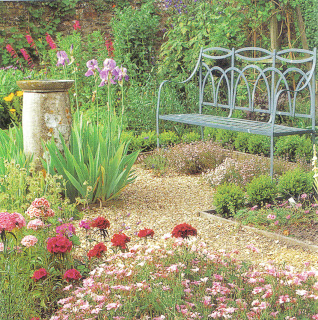
This cottage garden has a formal plan. The gravel paths provide the 'bones' of the design while the planting is sympathetically unstructured.
To enable the different elements of a garden to blend comfortably and attractively, there has to be a balance, which can to a large degree be dictated by the trees, shrubs and flowers that you choose.
By opting for plants that complement and harmonize with other aspects of the garden, such as the paving or lawn, and its overall size and shape, you can create a framework in which art and nature reach a happy equilibrium.
To help you choose plants to suit your garden's needs, concise descriptions of a wide range of trees, shrubs, roses, climbers, perennials, ground cover, bamboo, grasses, bulbs ans annuals and biennials, keep coming back and reading our blog because all these will be covered in great detail - you don't want to miss out now do you ;)
Principles of Planting
'Harmony' is perhaps the most important word in making a garden. You want somewhere that is relaxing but also stimulating to the senses, where art and nature have reached a happy equilibrium. Creating a balance between the different elements of a garden, such as the paving, lawn, trees, shrubs and flowers, is crucial to the end result.
Colour is an essential design element, but because flowers are relatively fleeting, it can be difficult to maintain interest all year long. The stronger the framework of the garden, with plenty of 'architectural' plants (those with strong and distinct shapes), the less vital it will be to have flowers all year round.
Small gardens are especially difficult to plan. All plants are highly visible, so there is no room for the spectacular flowering plant that looks messy for the rest of the year. Good foliage and flowers with a long season are vital.
Friday, 29 February 2008
Plants for the garden
Subscribe to:
Post Comments (Atom)



0 comments:
Post a Comment